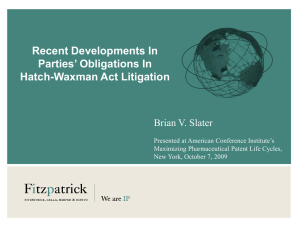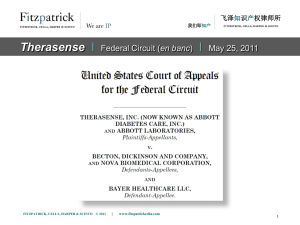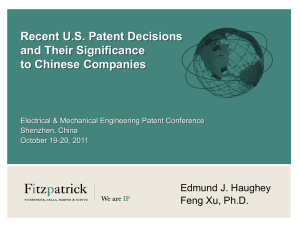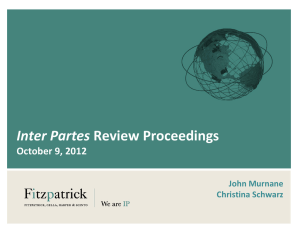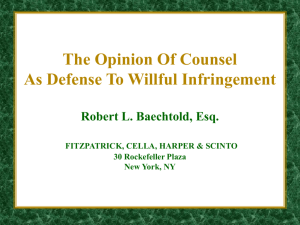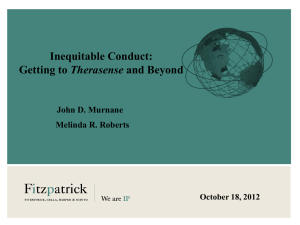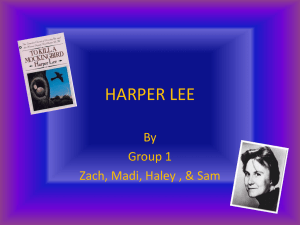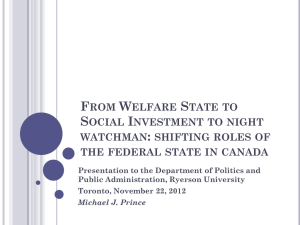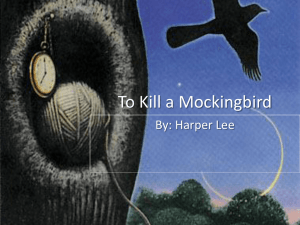Post Grant Challenges - Fitzpatrick, Cella, Harper & Scinto
advertisement
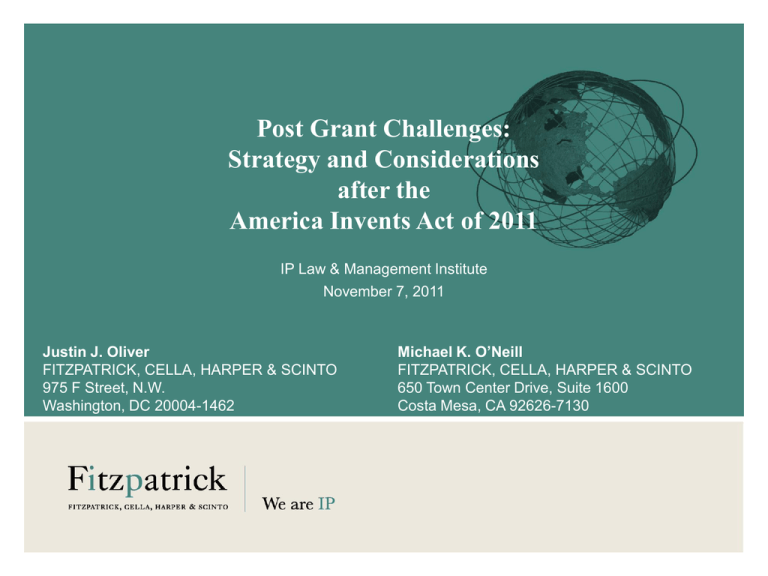
Post Grant Challenges: Strategy and Considerations after the America Invents Act of 2011 IP Law & Management Institute November 7, 2011 Justin J. Oliver FITZPATRICK, CELLA, HARPER & SCINTO 975 F Street, N.W. Washington, DC 20004-1462 Michael K. O’Neill FITZPATRICK, CELLA, HARPER & SCINTO 650 Town Center Drive, Suite 1600 Costa Mesa, CA 92626-7130 The Leahy-Smith America Invents Act of 2011 FITZPATRICK, CELLA, HARPER & SCINTO © 2011 | www.fitzpatrickcella.com 1 Topics AIA’s changes to post-grant challenges – What stays the same and what is new? Practice and procedure – What do we know (thus far) about the operation of the new proceedings? Strategies and considerations – How will post-grant practice change in general? – How do the changes help/hurt challengers? – How should in-house counsel plan for the changes? FITZPATRICK, CELLA, HARPER & SCINTO © 2011 | www.fitzpatrickcella.com 2 Changes to Post-Grant Challenges Before: Transition: After: Ex parte reexam Ex parte reexam Inter partes reexam Post grant review Ex parte reexam (virtually unchanged) Inter partes reexam – Transitional business methods program – Will be phased out in 1 year – Change of SNQ to “reasonable likelihood” Inter partes review Third party submission Post grant review – new – Business method patents – All other patents Inter partes review – new FITZPATRICK, CELLA, HARPER & SCINTO © 2011 | www.fitzpatrickcella.com 3 Changes to Post-Grant Challenges Immediate Changes – Change in standard for inter partes reexamination Substantial new question of patentability is now “reasonable likelihood that the petitioner would prevail with respect to at least 1 of the claims challenged.” September 16, 2012 – Post-Grant Review Transitional business method program Interferences – Inter Partes Review – all patents – End of inter partes reexamination – Third Party Submission of Prior Art FITZPATRICK, CELLA, HARPER & SCINTO © 2011 | www.fitzpatrickcella.com 4 Changes to Post-Grant Challenges March 16, 2013 – Post-Grant Review For non-business method applications having an effective filing date on or after this date • Keep in mind that applications with earlier effective filing dates are not eligible for Post-Grant Review FITZPATRICK, CELLA, HARPER & SCINTO © 2011 | www.fitzpatrickcella.com 5 Topics AIA’s changes to post-grant challenges – What stays the same and what is new? Practice and procedure – What do we know (thus far) about the operation of the new proceedings? Strategies and considerations – How will post-grant practice change in general? – How do the changes help/hurt challengers? – How should in-house counsel plan for the changes? FITZPATRICK, CELLA, HARPER & SCINTO © 2011 | www.fitzpatrickcella.com 6 Practice and Procedure Post-Grant Review Features – Transitional Business Method Patents Program Inter Partes Review Features Common Features FITZPATRICK, CELLA, HARPER & SCINTO © 2011 | www.fitzpatrickcella.com 7 Practice and Procedure – Post-Grant Review Timing – Petition must be filed not later than 9 months from date of grant of patent (or broadening reissue) Threshold – “that it is more likely than not that at least 1 of the claims challenged in the petition is unpatentable”; or – there is a “showing that the petition raises a novel or unsettled legal question that is important to other patents or patent applications” Scope – Arguments under §§ 101, 102, 103, and 112 (but not best mode) Applicability – Effective September 16, 2012 – Applies to patents having a claim with an effective filing date after March 16, 2013 FITZPATRICK, CELLA, HARPER & SCINTO © 2011 | www.fitzpatrickcella.com 8 Practice and Procedure – Post-Grant Review Transitional Program for Covered Business Method Patents – Allows for Post-Grant Review of business method patents after September 16, 2012 – Features unique to program: Must be sued or charged with infringement Applicable to all business method patents, regardless of filing date Estoppel only for grounds actually raised § 102(a) art • If not “by another” must be more than a year before filing date FITZPATRICK, CELLA, HARPER & SCINTO © 2011 | www.fitzpatrickcella.com 9 Practice and Procedure – Inter Partes Review Timing – Petition can be filed after 9 months from date of grant or after termination of a Post-Grant Review (includes broadening reissue) Threshold – There is “a reasonable likelihood that petitioner would prevail with respect to at least 1 claim of the claims” Scope – Arguments under §§ 102 and 103, based on patents and printed publications (same as inter partes reexam) Applicability – Effective September 16, 2012 – Applies to all patents (replaces inter partes reexamination) FITZPATRICK, CELLA, HARPER & SCINTO © 2011 | www.fitzpatrickcella.com 10 Practice and Procedure – Common Features Initial Determination – Petition filed by challenger – Patent owner may file response – USPTO issues decision on petition within 3 months of Patent Owner response (or deadline for response) Not appealable FITZPATRICK, CELLA, HARPER & SCINTO © 2011 | www.fitzpatrickcella.com 11 Practice and Procedure – Common Features Conduct During Review – Before panel of judges at the Board Removes Examiners from process – Limited discovery – Patent owner may amend the patent to: (1) Cancel a challenged claim; or (2) Propose a reasonable number of substitute claims Similar to EP Opposition practice, and cuts down on new claim binges common in current inter partes practice – Each side will have chance to file comments and request an oral hearing – Final determination to issue within 1 year USPTO may extend deadline by 6 months for good cause FITZPATRICK, CELLA, HARPER & SCINTO © 2011 | www.fitzpatrickcella.com 12 Practice and Procedure – Common Features Settlement – Joint request for termination with respect to a Petitioner who is settling Terminated with respect to that Petitioner unless the USPTO has decided the merits – USPTO might or might not terminate the proceedings If no Petitioner remains USPTO may still proceed to a final written decision – No estoppel attaches with respect to a terminated Petitioner – Settlement must be in writing and made of record FITZPATRICK, CELLA, HARPER & SCINTO © 2011 | www.fitzpatrickcella.com 13 Practice and Procedure – Common Features Estoppel – If a review results in a final decision by the Board, the petitioner may not challenge the claim before the USPTO or court based on any ground the petitioner raised or reasonably could have raised – Changes “Reasonably” could have raised Attaches with Board decision, as opposed to final appeal – Estoppel does not attach in EP oppositions – still a big difference – Common (and unresolved) concerns: That new art will be uncovered during discovery and trial prep That post grant challenges will tie client’s hand with respect to art turned up during discovery, but after start of a review FITZPATRICK, CELLA, HARPER & SCINTO © 2011 | www.fitzpatrickcella.com 14 Practice and Procedure – Common Features Intervening Rights – Standard: Any amended or new claim shall have the same effect as that for reissued patents with respect to the right of any person who, before the issuance of the certificate: • made, purchased, or used within the United States anything patented by the amended or new claim, • imported into the United States anything patented by the amended or new claim, or • made substantial preparation therefor Amended claims should eliminate past damages, even if new/amended claim still covers accused device/process FITZPATRICK, CELLA, HARPER & SCINTO © 2011 | www.fitzpatrickcella.com 15 Comparison Ex parte Inter partes Post-grant review reexamination reexamination Inter partes review Transitional postgrant review for business methods Timing Anytime postissuance Anytime postissuance Within 9 months from grant (but before challenger files a lawsuit) After 9 months from grant (but before challenger files a lawsuit) Only after challenger has been sued for or charged with infringement Eligibility Any patent Any patent Patent filed under FITF - OR Dismissed interference - OR Business method patent Any patent Any business method patent Threshold SNQ Reasonable likelihood that the requester would prevail More likely than not that a claim is unpatentable - OR novel or unsettled legal question Reasonable likelihood that the requester would prevail Same as PostGrant Review Basis Patents or printed publications Patents or printed publications Any ground that could be raised in Patents or litigation under 35 USC printed § 282(b)(2) or (3) (including §§ publications 101, 102, 103, 112) FITZPATRICK, CELLA, HARPER & SCINTO © 2011 | www.fitzpatrickcella.com Same as PostGrant Review, but with limitations to § 102(a) of current statute 16 Comparison - continued Ex parte reexamination Inter partes reexamination Post-grant review Inter partes review Transitional postgrant review for business methods Anonymity Yes No No No No Interviews Yes No No No No Discovery None None Limited Limited Limited Time Limit on USPTO None (“special dispatch”) None (“special dispatch”) One year (extendable to 18 months) One year (extendable to 18 months) One year (extendable to 18 months) Early termination No Possible Joint request (specific to petitioner); any agreement must be submitted Joint request (specific to petitioner); any agreement must be submitted Joint request (specific to petitioner); any agreement must be submitted Estoppel None Any ground raised or that could have been raised Any ground raised or reasonably could have been raised, unless settled Any ground raised or reasonably could have been raised, unless settled Only grounds actually raised Intervening rights Yes Yes Yes Yes Yes FITZPATRICK, CELLA, HARPER & SCINTO © 2011 | www.fitzpatrickcella.com 17 Topics AIA’s changes to post-grant challenges – What stays the same and what is new? Practice and procedure – What do we know (thus far) about the operation of the new proceedings? Strategies and considerations – How will post-grant practice change in general? – How do the changes help/hurt challengers? – How should in-house counsel plan for the changes? FITZPATRICK, CELLA, HARPER & SCINTO © 2011 | www.fitzpatrickcella.com 18 Strategies and Considerations – General Practice Practicing before the Board – Will reviews operate, procedurally, like interferences? Experts and declarations become more critical • Board prefers “evidence” • Experts will now be subject to cross-examination Claim deluge to be reduced – Current practice gives patent owners incentive to submit numerous new claims during reexaminations “reasonable number” of “substitute” claims changes that Cost – Declarations and cross-examinations increase cost – Removal of Central Reexam Unit layer reduces cost – Shortened period likely means no multiple non-final actions – Fewer claims, lower cost FITZPATRICK, CELLA, HARPER & SCINTO © 2011 | www.fitzpatrickcella.com 19 Strategies and Considerations – Tactical Considerations New Threshold – Higher than former threshold of “substantial new question” (SNQ) “reasonable likelihood” for inter partes review/reexam “more likely than not” for post-grant review – 95% of inter partes requests granted under SNQ threshold Explicit intent of Congress to cut back on that number – Will work against challengers – Unlike EP Opposition practice FITZPATRICK, CELLA, HARPER & SCINTO © 2011 | www.fitzpatrickcella.com 20 Strategies and Considerations – Tactical Considerations New Threshold (continued) – Will the higher threshold matter in the overall analysis? Real issue is likelihood of invalidating claims, which may or may not change Even if odds change, will they be better than in district court? • USPTO is typically more receptive to § 103 rejections • USPTO uses broader claim interpretation and de novo review – Expected changes with new threshold Lower chance of appeal to Federal Circuit • Can still get there through district court, but uphill battle First action allowances will likely go away FITZPATRICK, CELLA, HARPER & SCINTO © 2011 | www.fitzpatrickcella.com 21 Strategies and Considerations – Tactical Considerations New Grounds for Invalidity Under Post-Grant Review – “any ground that could be raised under paragraph (2) or (3) of section 282(b)” §§ 102 and 103 • Beyond printed publications § 101 • Most useful in business method and biotech patents • Quicker (and cheaper) route to Federal Circuit • No longer have to wait for litigation or threat of litigation § 112 • Indefiniteness • Lack of written description • Enablement FITZPATRICK, CELLA, HARPER & SCINTO © 2011 | www.fitzpatrickcella.com 22 Strategies and Considerations – Tactical Considerations Streamlined Process – Current inter partes reexam takes too long If a stay is not granted, litigation is likely to finish before reexam • This renders the reexam is of little use, but an added expense Long timeline was likely to make more courts deny stays – New procedures Direct to Board Decision in 1 -1.5 years Result: • Now more attractive option when sued in a plaintiff friendly jurisdiction • Better argument for stay FITZPATRICK, CELLA, HARPER & SCINTO © 2011 | www.fitzpatrickcella.com 23 Strategies and Considerations – Tactical Considerations Estoppel – Not significantly changed relative to current inter partes reexams Any ground that the petitioner raised or “reasonably” could have raised • Available or known to you? – Different than European opposition practice – Common concern: Later discovered prior art (e.g., discovery) – Does not attach if petitioner settles and the challenge is terminated with respect to the petitioner – Bottom line: Must be confident that you have been diligent in your search for the best prior art FITZPATRICK, CELLA, HARPER & SCINTO © 2011 | www.fitzpatrickcella.com 24 Strategies and Considerations – Tactical Considerations Overall question: – Which avenue gives you the best chance of success for invalidation USPTO vs. district court Considerations – Will overall success rates for post-grant challenges change? – Are you in a plaintiff friendly venue? – How deep is your knowledge of the prior art? – How worried are you about new/amended claims? – Cost? In general, the new law works in favor of challengers FITZPATRICK, CELLA, HARPER & SCINTO © 2011 | www.fitzpatrickcella.com 25 Strategies and Considerations – Looking Beyond Challenges Are you already tracking competitor patents? – Will need to do so for Post-Grant Review – Docketing systems will need to track deadlines for challenging Do you need to budget for reviews filed against your patents? – 5% of European patents face opposition – Will European numbers be a guide? Estoppel may continue to keep the U.S. numbers down European practice is unique in that it provides the last opportunity to challenge in a single forum But, U.S. practice will combine Post-Grant Review and Inter Partes Review, providing more opportunity for challenge than in European practice FITZPATRICK, CELLA, HARPER & SCINTO © 2011 | www.fitzpatrickcella.com 26 Strategies and Considerations – Preference by Industry Rate of Oppositions in EPO Other fields Mechanical engineering Instruments 2007-2008 2005-2006 2003-2004 2000-2002 Electrical engineering Chemistry Overall Rate 0% 1% 2% 3% 4% 5% 6% 7% 8% 9% 10% Source: G. Scellato, et al., "Study on the Quality of the Patent System in Europe“, European Commission (March 2011) FITZPATRICK, CELLA, HARPER & SCINTO © 2011 | www.fitzpatrickcella.com 27 NEW YORK 1290 Avenue of the Americas New York, NY 10104-3800 212.218.2100 WASHINGTON 975 F Street, NW Washington, DC 20004-1405 202.530.1010 CALIFORNIA 650 Town Center Drive, Suite 1600 Costa Mesa, CA 92626-7130 714.540.8700 FCHS_WS # 7068199v1.ppt FITZPATRICK, CELLA, HARPER & SCINTO © 2011 | www.fitzpatrickcella.com 28
